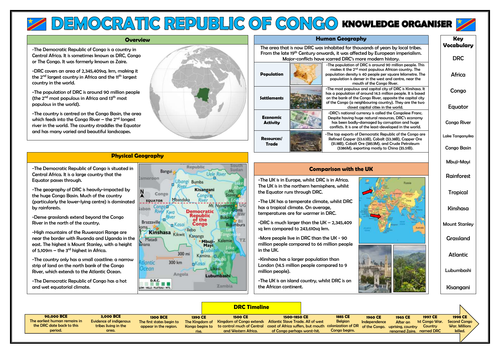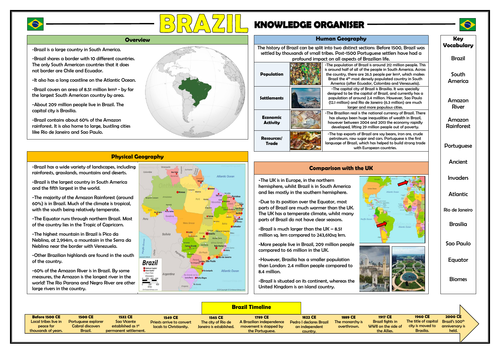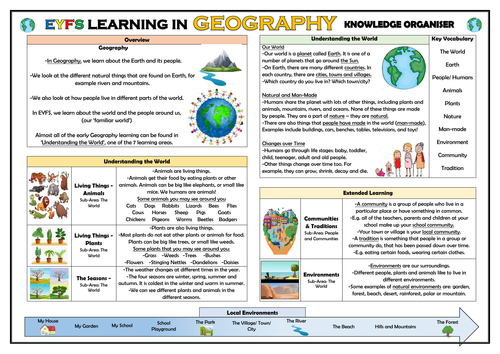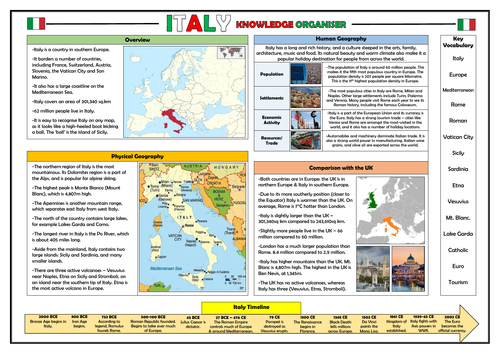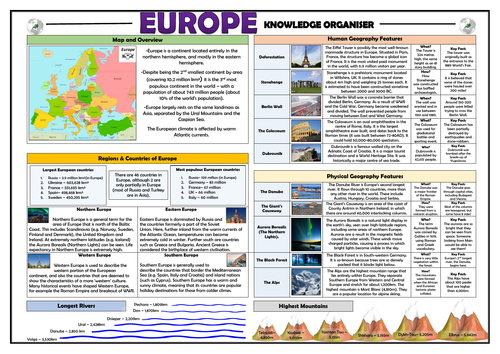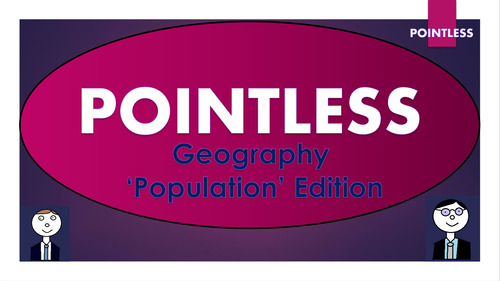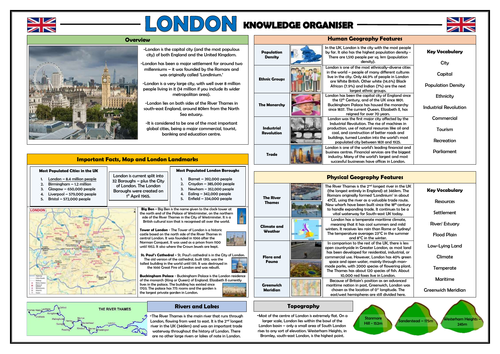
3k+Uploads
1874k+Views
2215k+Downloads
Geography

Democratic Republic of Congo Knowledge Organiser - Geography Place Knowledge!
This clear, detailed and visually-appealing resource offers a complete reference point for students revising knowledge relating to the Democratic Republic of Congo, as a part of their study of place, human and physical geography. It contains the following sections:
Overview and Maps;
Physical Geography;
Human Geography;
Comparison with the United Kingdom;
DRC Timeline;
Key Vocabulary.
The resource is designed to be printed onto A3, and is provided as both a PDF and a Word version (so that you can edit if you want to). All images used are licensed for commercial use and are cited on a separate document (included).

Africa Knowledge Organiser/ Revision Mat!
This clear, detailed and visually-appealing resource offers a complete reference point for students revising knowledge relating to Africa, as a part of their study of physical and human geography. It contains comprehensive sections on:
Overview and map;
Regions and Countries of Africa;
Longest Rivers;
Highest Mountains;
Human Geography Features;
Physical Geography Features.
The resource is designed to be printed onto A3, and is provided as both a PDF and a Word version (so that you can edit if you want to). All images used are licensed for commercial use and are cited on a separate document (included). The resource is most suitable for students in KS2 or KS3.

North America Knowledge Organiser/ Revision Mat!
This clear, detailed and visually-appealing resource offers a complete reference point for students revising knowledge relating to North America, as a part of their study of physical and human geography. It contains comprehensive sections on:
Overview and map;
Regions and Countries of North America;
Longest Rivers;
Highest Mountains;
Human Geography Features;
Physical Geography Features.
The resource is designed to be printed onto A3, and is provided as both a PDF and a Word version (so that you can edit if you want to). All images used are licensed for commercial use and are cited on a separate document (included). The resource is most suitable for students in KS2 or KS3.

Brazil Knowledge Organiser - KS2 Geography Place Knowledge!
This clear, detailed and visually-appealing resource offers a complete reference point for students revising knowledge relating to Brazil, as a part of their study of place, human and physical geography (‘understand geographical similarities and differences through the study of human and physical geography of a region of the United Kingdom…and a region of South America.’)
I coupled this with our learning of rainforests, to provide children with a more in-depth understanding. It contains comprehensive sections on:
Overview and Maps;
Physical Geography;
Human Geography;
Comparison with the United Kingdom;
Brazil Timeline;
Key Vocabulary.
The resource is designed to be printed onto A3, and is provided as both a PDF and a Word version (so that you can edit if you want to). All images used are licensed for commercial use and are cited on a separate document (included).

Seven Natural Wonders Descriptive Writing Challenge - Lessons 1 and 2!
These highly engaging and purposeful lessons are the first two lessons in a series of six building towards an extended creative writing piece based on the ‘Seven Natural Wonders of the World.’
In these lessons, children learn:
-What nouns, verbs, adjectives and adverbs are, and how to use these ‘base words’ for clarity and effect in their writing;
-About each of the Seven Wonders of the world, through viewing pictures and reading key facts;
-How to use base words and their five senses to begin to describe the natural wonders, moving from word level to sentence level over the two lessons;
Included is the clear, comprehensive and colourful PowerPoint presentation for both lessons (24 slides) and the worksheets/templates needed for the 3 main activities (provided in both Word and PDF).
In the past, I have used these lessons with children in lower KS2 (years 3 and 4) - the key learning is aligned with curriculum expectations for writing. All images are licensed for commercial use.

Seven Natural Wonders Descriptive Writing Challenge - Lessons 5 and 6!
These highly engaging and purposeful writing lessons are the final two lessons in a series of six building towards an extended creative writing piece based on the ‘Seven Natural Wonders of the World.’
These two lessons move the children on from sentence level ideas, to considering whole text structure and cohesion. Throughout the lessons, children learn:
-What the different types of connectives are, and how these can be used to build cohesion within and between paragraphs;
-How whole texts can be structured for clarity and effect;
-How to punctuate their work accurately - they then use this information to edit and redrafts sections of their writing.
Included is the clear, comprehensive and colourful PowerPoint presentation for both lessons (22 slides), the worksheet needed for the main activity, and the structure strip (both provided in Word and PDF).
In the past, I have used these lessons with children in lower KS2 (years 3 and 4) - the key learning is aligned with curriculum expectations for writing. All images are licensed for commercial use.

Seven Natural Wonders Descriptive Writing Challenge - Lessons 3 and 4!
These highly engaging and purposeful writing lessons are lessons 3 and 4 in a series of six building towards an extended creative writing piece based on the ‘Seven Natural Wonders of the World.’
These two lessons move the children on from word level to sentence level ideas. Throughout the lessons, children learn:
-What similes, metaphors, alliteration, onomatopoeia, and personification are, and how to use these ‘descriptive devices’ for clarity and effect in their writing;
-How to use fronted adverbials to add further detail and variety to their natural wonders sentences.
Included is the clear, comprehensive and colourful PowerPoint presentation for both lessons (22 slides) and the worksheets/templates needed for the 2 main activities (provided in both Word and PDF).
In the past, I have used these lessons with children in lower KS2 (years 3 and 4) - the key learning is aligned with curriculum expectations for writing. All images are licensed for commercial use.

EYFS Learning in Geography - Knowledge Organiser!
This clear, detailed and visually-appealing resource helps to detail and categorise the foundation Geography learning that takes place in the EYFS stage.
It is an important resource for EYFS teachers and parents, but also Geography subject leaders, to aid them in the development of a clearly-mapped and well-sequenced Geography curriculum across the school.
This organiser groups the Geography related learning into the relevant EYFS areas of learning (for Geography, this is mainly 'Understanding the World - The World, but also ‘Understanding the World - People and Communities’). There is also a section detailing extended EYFS geography knowledge.
The resource is designed to be printed onto A3, and is provided as both a PDF and a Word version (so that you can edit if you want to). All images used are licensed for commercial use and are cited on a separate document (included).
Bundle Sale

Subject Foundations in EYFS - Knowledge Organisers Bundle!
These clear, detailed and visually-appealing resources help to detail and categorise the EYFS foundation learning in each of the primary curriculum subject areas
It is an important resource for EYFS teachers and parents, but also subject leaders, to aid them in the development of a clearly-mapped and well-sequenced subject curriculum across the school.
This organiser groups the subject-related learning into the relevant EYFS areas of learning (e.g. Understanding the World, Expressive Arts and Design, Communication and Language, etc.)
The resources are designed to be printed onto A3, and are provided as both PDF and Word documents (so that you can edit if you want to). All images used are licensed for commercial use and are cited on a separate document (included).
Bundle Sale

Seven Natural Wonders Descriptive Writing Challenge - Lesson Bundle!
These highly engaging and purposeful lessons aim to develop a number of important creative writing skills, whilst towards an extended descriptive piece based on the ‘Seven Natural Wonders of the World.’
The lessons are sequenced thoughtfully, progressing children from their initial word level ideas, through sentence level construction, to whole-text composition.
The lessons included are:
Building Base Vocabulary
Using the Senses
Descriptive Devices
Fronted Adverbials
Whole Text Cohesion and Connectives
Editing and Redrafting.
The lessons also build children’s understanding of each of the seven natural wonders, which links well to geography/ environmental cross-curricular study.
Included are each of the clear, eye-catching, comprehensive PowerPoint presentations (these will guide you through the step-by-step journey for each lesson), the worksheets/templates needed for the main activities, and the structure strip for the extended writing piece (all provided in both Word and PDF).
In the past, I have used these lessons with children in lower KS2 (years 3 and 4) - the key learning is aligned with curriculum expectations for writing. All images are licensed for commercial use.
Bundle Sale

Biomes - Knowledge Organisers Bundle!
These clear, detailed and visually-appealing resources offer a complete reference point for students revising knowledge relating to each of the world’s five major biomes, as a part of their study of physical geography:
-Aquatic
-Deserts
-Forests
-Grasslands
-Tundra
Each organiser contains the following information:
-Definition/ Overview of the Biome;
-Animal and Plant Life in the Biome;
-Well-Known Examples of the Biome;
-Types and Locations of the Biome;
-Important Facts and Figures;
-Key Vocabulary.
The organisers are designed to help children to learn the relevant physical geography knowledge from areas of both the KS2 and KS3 Geography National Curriculum, however they can be adapted for other age groups if necessary.
The resources can be printed onto A3 or A4, and are provided as both PDF and Word versions (so that you can edit if you want to). All images used are licensed for commercial use and are cited on a separate document (included).

Italy Knowledge Organiser - KS2 Geography Place Knowledge!
This clear, detailed and visually-appealing resource offers a complete reference point for students revising knowledge relating to Italy, as a part of their study of place, human and physical geography. It contains comprehensive sections on:
Overview and Maps;
Physical Geography;
Human Geography;
Comparison with the United Kingdom;
Italy Timeline;
Key Vocabulary.
The organiser is designed to help children to learn the relevant place, human and physical geography knowledge from the KS2 Geography National Curriculum: -‘understand geographical similarities and differences through the study of human and physical geography of a region of the United Kingdom and a region in a European country’
‘physical geography, including: climate zones, rivers, mountains, volcanoes and earthquakes’
-‘human geography, including: types of settlement and land use, economic activity
including trade links, and the distribution of natural resources including energy.’
The resource is designed to be printed onto A3, and is provided as both a PDF and a Word version (so that you can edit if you want to). All images used are licensed for commercial use and are cited on a separate document (included).
Bundle Sale

Huge Primary Geography Knowledge Organisers Bundle!
These clear, detailed and visually-appealing resources offer a complete reference point for planning, learning and revising all areas of the entire Primary Geography National Curriculum.
The KS1 knowledge organisers included are:
-Polar Explorers;
-The Seven Continents;
-Oceans and Seas;
-Capital Cities;
-The United Kingdom;
The KS2 knowledge organisers included are:
-Rivers;
-Rainforests;
-Latitude and Longitude;
-Human and Natural Disasters;
-North America;
-South America;
-Europe;
-Italy (European Comparison);
-Greece (European Comparison);
-Peru (South America Comparison);
-London;
There is also an organiser for each key stage that can be adapted for whichever area of local study you choose to cover (the templates provided focus on ‘Exploring Essex’ for KS1 and ‘East Anglia’ for KS2.)
The organisers are separated into logical compartments, based on the key curriculum expectations.
Each resource is designed to be printed onto A3, and is provided as both a PDF and a Word version (so that you can edit if you want to). All images used are licensed for commercial use and are cited on a separate document (included).

Europe Knowledge Organiser/ Revision Mat!
This clear, detailed and visually-appealing resource offers a complete reference point for students revising knowledge relating to Europe, as a part of their study of physical and human geography. It contains comprehensive sections on:
Overview and map;
Regions and Countries of Europe;
Longest Rivers;
Highest Mountains;
Human Geography Features;
Physical Geography Features.
The resource is designed to be printed onto A3, and is provided as both a PDF and a Word version (so that you can edit if you want to). All images used are licensed for commercial use and are cited on a separate document (included). The resource is most suitable for students in KS2 or KS3.

Peru Knowledge Organiser - KS2 Geography Place Knowledge!
This clear, detailed and visually-appealing resource offers a complete reference point for students revising knowledge relating to Peru, as a part of their study of place, human and physical geography (‘understand geographical similarities and differences through the study of human and physical geography of a region of the United Kingdom…and a region of South America.’)
I coupled this with our Incas history learning, to provide children with a more in-depth understanding. It contains comprehensive sections on:
Overview and Maps;
Physical Geography;
Human Geography;
Comparison with the United Kingdom;
Peru Timeline;
Key Vocabulary.
The resource is designed to be printed onto A3, and is provided as both a PDF and a Word version (so that you can edit if you want to). All images used are licensed for commercial use and are cited on a separate document (included).

Pointless - Geography 'Populations' Edition
Based on the popular game show 'Pointless', this resource is perfect for use as a starter activity, plenary, or revision tool. Editable, so that you can change to any other topic or change the questions/answers. Containing sound clips, engaging visuals, and suitably challenging questions, this resource is effective at both promoting engagement and enhancing learning.
There are several full rounds of questions to build students' understanding of populations, including:
- Naming the most populous countries in the world;.
- Defining key 'populations' terminology;;
- Unscrambling puzzles to identify populous regions;
- Thinking about the most densely populated places in a local area.
The nature of the game ensures that this resource can challenge students of all levels.
NOTE: You can buy this resource alone, or in a bundle of 8 Pointless games, for only £1 more!

London - Upper KS2 Place Knowledge - Geography Knowledge Organiser!
This clear, detailed and visually-appealing resource offers a complete reference point for upper KS2 students learning or revising knowledge relating to London, as a part of their place knowledge in geography. It contains comprehensive sections on:
Overview;
Places/ Landmarks in London;
Key Facts and Maps;
Rivers and Lakes/ River Thames;
Topography/ Highest Hills;
Human Geography Features;
Physical Geography Features;
Key Vocabulary.
The resource is designed to be printed onto A3, and is provided as both a PDF and a Word version (so that you can edit if you want to). All images used are licensed for commercial use and are cited on a separate document (included). The resource is aligned with the expectations of the geography national curriculum.

Comparison of the UK and Italy - Geography Knowledge Organiser!
This clear, detailed and visually-appealing resource offers a complete reference point for students revising knowledge relating to the UK and Italy, as a part of their study of their KS2 place, human and physical geography. It contains comprehensive sections on:
Key Facts Overview and Maps;
Physical Geography Comparison;
Human Geography Comparison;
10 Key Comparison Facts;
Key Vocabulary.
The organiser is designed to help children to learn the relevant place, human and physical geography knowledge from the KS2 Geography National Curriculum: -‘understand geographical similarities and differences through the study of human and physical geography of a region of the United Kingdom and a region in a European country’
‘physical geography, including: climate zones, rivers, mountains, volcanoes and earthquakes’
-‘human geography, including: types of settlement and land use, economic activity
including trade links, and the distribution of natural resources including energy.’
The resource is designed to be printed onto A3, and is provided as both a PDF and a Word version (so that you can edit if you want to). All images used are licensed for commercial use and are cited on a separate document (included).

Comparing the UK and Italy - Settlements, Resources and Trade!
This clear and purposeful lessons enables children to begin making comparisons between the UK and Italy, as a part of their KS2 geography study.
In this lesson, children learn about the different types of ‘settlements’ before comparing different settlements in the UK and Italy. They consider how the reasons for the formation of settlements is often linked to resources and trade. The lesson includes a 17 slide PowerPoint presentation, guiding learners through the lesson, and a research template for the main activity (provided in both Word and PDF).
The lesson is a part of a series of lessons designed to help children to learn the relevant place, human and physical geography knowledge from the KS2 Geography National Curriculum: -‘understand geographical similarities and differences through the study of human and physical geography of a region of the United Kingdom and a region in a European country;’
‘physical geography, including: climate zones, rivers, mountains, volcanoes and earthquakes;’
-‘human geography, including: types of settlement and land use, economic activity including trade links, and the distribution of natural resources including energy.’
All images used are licensed for commercial use.

Comparing the UK and Italy - Climate and Biomes!
This clear and purposeful lessons enables children to begin making comparisons between the UK and Italy, as a part of their KS2 geography study.
In this lesson, children understand the key terms ‘climate’ and ‘biome’ before comparing the climate and biomes of areas of the UK and Italy. It includes a 17 slide PowerPoint presentation, guiding learners through the lesson, and a research template for the main activity (provided in both Word and PDF).
The lesson is a part of a series of lessons designed to help children to learn the relevant place, human and physical geography knowledge from the KS2 Geography National Curriculum: -‘understand geographical similarities and differences through the study of human and physical geography of a region of the United Kingdom and a region in a European country;’
‘physical geography, including: climate zones, rivers, mountains, volcanoes and earthquakes;’
-‘human geography, including: types of settlement and land use, economic activity including trade links, and the distribution of natural resources including energy.’
All images used are licensed for commercial use.

